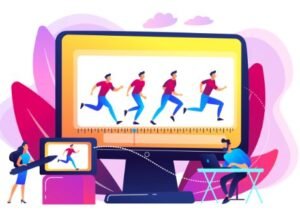Motion Graphics Training- Essential Skills for Creative Professionals
Motion graphics training equips creative professionals with the skills needed to design and animate captivating visual content. As digital media becomes increasingly integral to marketing, entertainment, and communication, mastering motion graphics can significantly enhance your career opportunities. This article delves into the key aspects of motion graphics training, exploring the benefits, essential skills, and effective methods for learning.

Understanding Motion Graphics
Motion graphics combine graphic design and animation to create engaging visuals that move. Unlike traditional static graphics, motion graphics involve the use of time-based elements to bring designs to life. This can include animated text, shapes, and images that convey information or tell a story. Understanding the basics of motion graphics is crucial for anyone looking to excel in this field.
Essential Skills for Motion Graphics
Effective motion graphics training covers a range of skills that are essential for creating compelling animations. These skills include:
- Design Principles: A solid foundation in design principles is crucial. This includes understanding color theory, typography, composition, and visual hierarchy. These principles help ensure that your motion graphics are aesthetically pleasing and effective in conveying the intended message.
- Animation Techniques: Mastery of animation techniques is fundamental. This involves learning about keyframes, easing functions, and motion paths. Understanding these concepts allows you to create smooth and fluid animations that capture viewers’ attention.
- Software Proficiency: Familiarity with industry-standard software is essential. Tools such as Adobe After Effects, Cinema 4D, and Adobe Animate are commonly used in motion graphics. Proficiency in these programs enables you to execute complex animations and integrate various design elements seamlessly.
- Storytelling: Motion graphics often serve to tell a story or convey a message. Developing storytelling skills helps you create animations that engage and resonate with your audience. This includes crafting a narrative structure and using visual elements to enhance the story.
Benefits of Motion Graphics Training
Enrolling in motion graphics training offers several benefits, including:
- Career Advancement: Motion graphics skills are highly sought after in various industries, including advertising, film, television, and digital media. Training can open doors to career opportunities and help you stand out in a competitive job market.
- Creative Expression: Motion graphics provide a unique medium for creative expression. Training allows you to explore different styles and techniques, enabling you to produce original and innovative work that reflects your artistic vision.
- Enhanced Problem-Solving: Motion graphics training often involves tackling complex design and animation challenges. This process enhances your problem-solving skills, as you learn to address technical issues and find creative solutions.
- Portfolio Development: A well-rounded training program can help you build a strong portfolio showcasing your skills and projects. A compelling portfolio is crucial for attracting potential clients or employers and demonstrating your expertise.
Methods for Learning Motion Graphics
There are various methods for acquiring motion graphics skills, each offering different advantages:
- Online Courses: Online platforms offer a range of motion graphics courses, from beginner to advanced levels. These courses often provide video tutorials, interactive exercises, and feedback from instructors. Online learning allows you to study at your own pace and access resources from anywhere.
- Formal Education: Many universities and design schools offer degree programs in graphic design, animation, or multimedia arts that include motion graphics training. Formal education provides a structured learning environment and access to experienced instructors.
- Workshops and Bootcamps: Short-term workshops and bootcamps focus on intensive, hands-on learning. These programs are designed to teach specific skills or techniques in a condensed timeframe. Workshops often provide practical experience and direct feedback from industry professionals.
- Self-Study: For those with a strong sense of self-motivation, self-study can be a viable option. This involves using online tutorials, books, and practice projects to develop your skills. Self-study requires discipline but can be highly flexible and cost-effective.
Explore the World of G.H. Dean
Discover the works and insights of G.H. Dean, exploring various topics and perspectives. Engage with thoughtful content and delve into new ideas. For those with diverse online interests, you can find information about online casinos australia.
Building a Career in Motion Graphics
Once you have acquired the necessary skills through motion graphics training, building a career involves several steps:
- Networking: Connect with industry professionals and peers through online forums, social media, and industry events. Networking can lead to collaborations, job opportunities, and valuable insights into industry trends.
- Freelancing or Employment: Decide whether to pursue freelance opportunities or seek employment with a design studio, advertising agency, or production company. Both paths offer unique advantages and challenges, so consider your career goals and preferences.
- Continuing Education: The field of motion graphics is constantly evolving, with new tools and techniques emerging regularly. Staying updated with industry trends and continuing education ensures that your skills remain relevant and competitive.
- Personal Projects: Engage in personal projects to showcase your creativity and apply your skills. Personal projects can serve as valuable portfolio pieces and demonstrate your ability to tackle diverse design challenges.
Personal Blog & Reflections
Insightful commentary and life experiences shape the tone of this personal space. Alongside thoughtful content, the thrill of competition is also captured through cansportsbetting sports betting canada. It connects followers to real-time sporting energy.
Conclusion
Motion graphics training is a vital step for anyone looking to excel in the world of digital design and animation. By mastering essential skills such as design principles, animation techniques, and software proficiency, you can create engaging and impactful visual content. Whether through online courses, formal education, or self-study, investing in motion graphics training can enhance your career prospects and provide opportunities for creative expression. Embrace the learning process, stay updated with industry trends, and build a portfolio that highlights your skills and creativity. With the right training and dedication, you can make a significant impact in the dynamic field of motion graphics.



